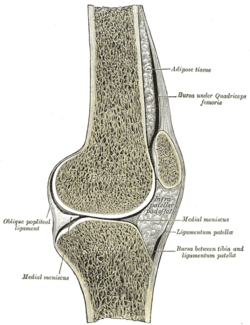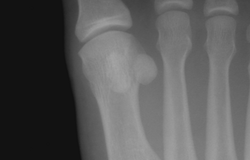Sesamoid bone: Difference between revisions
No edit summary |
No edit summary |
||
| Line 11: | Line 11: | ||
| MeshNumber = |
| MeshNumber = |
||
}} |
}} |
||
In [[anatomy]], a '''sesamoid bone''' ({{IPAc-en|'|s|ɛ|s|əm|ɔɪ|d}}<ref>''[[OED]]'' 2nd edition, 1989 as {{IPA|/sεsəmɔɪd/}}.</ref><ref>[http://www.merriam-webster.com/dictionary/sesamoid Entry "sesamoid"] in ''[http://www.merriam-webster.com/ Merriam-Webster Online Dictionary]''.</ref>) is a [[bone]] embedded within a [[tendon]] or a [[muscle]].<ref name="aofas.org">{{cite web|url=http://www.aofas.org/footcaremd/conditions/ailments-of-the-big-toe/Pages/Sesamoiditis.aspx|title=Sesamoid Injuries|author=|date=|work=aofas.org}}</ref> It is derived from the Latin word "sesamum" (sesame seed |
In [[anatomy]], a '''sesamoid bone''' ({{IPAc-en|'|s|ɛ|s|əm|ɔɪ|d}}<ref>''[[OED]]'' 2nd edition, 1989 as {{IPA|/sεsəmɔɪd/}}.</ref><ref>[http://www.merriam-webster.com/dictionary/sesamoid Entry "sesamoid"] in ''[http://www.merriam-webster.com/ Merriam-Webster Online Dictionary]''.</ref>) is a [[bone]] embedded within a [[tendon]] or a [[muscle]].<ref name="aofas.org">{{cite web|url=http://www.aofas.org/footcaremd/conditions/ailments-of-the-big-toe/Pages/Sesamoiditis.aspx|title=Sesamoid Injuries|author=|date=|work=aofas.org}}</ref> It is derived from the Latin word "sesamum" (sesame seed. Often, these bones form in response to strain.<ref name="auto">Kenneth S. Saladin, ''Anatomy and Physiology'', 6th edition (New York:McGraw Hill, 2012), 234.</ref> Sesamoids act like [[pulley]]s, providing a smooth surface for tendons to slide over increasing the tendon's ability to transmit [[Muscle#Function|muscular force]]s.<ref name="aofas.org"/> |
||
==Structure== |
==Structure== |
||
Revision as of 22:09, 2 November 2015
| Sesamoid bone | |
|---|---|
 Sagittal section of right knee-joint. | |
 Sesamoid bones at the distal end of the first metatarsal bone of the foot. | |
| Details | |
| Identifiers | |
| Latin | ossa sesamoidea |
| MeSH | D012716 |
| TA98 | A02.0.00.016 |
| TA2 | 374 |
| FMA | 32672 |
| Anatomical terms of bone | |
In anatomy, a sesamoid bone (/ˈsɛsəmɔɪd/[1][2]) is a bone embedded within a tendon or a muscle.[3] It is derived from the Latin word "sesamum" (sesame seed. Often, these bones form in response to strain.[4] Sesamoids act like pulleys, providing a smooth surface for tendons to slide over increasing the tendon's ability to transmit muscular forces.[3]
Structure
Sesamoid bones can be found on joints throughout the body, including:
- In the knee — the patella (within the quadriceps tendon). This is the largest sesamoid bone.[4]
- In the hand — two sesamoid bones are commonly found in the distal portions of the first metacarpal bone (within the tendons of adductor pollicis and flexor pollicis brevis). There is also commonly a sesamoid bone in distal portions of the second metacarpal bone.
- In the wrist - The pisiform of the wrist is a sesamoid bone (within the tendon of flexor carpi ulnaris).[5] It is not present at birth and generally develops in children ages 9–12.[6]
- In the foot - the first metatarsal bone usually has two sesamoid bones at its connection to the big toe (both within the tendon of flexor hallucis brevis).[7] One is found on the lateral side of the first metatarsal while the other is found on the medial side. In some people, only a single sesamoid is found on the first MTP.

- In the neck - Although the hyoid bone is free floating, it is not technically a sesamoid bone. All sesamoid bones form directly from the connective tissue found in tendons and ligaments. By contrast, the hyoid bone forms from a cartilaginous precursor like most other bones in the body.
- In the ear - the lenticular process of incus is a sesamoid bone and therefore is considered the fourth ossicle of middle ear
Clinical significance
- A common foot ailment in dancers is sesamoiditis. This is a form of tendinitis which results from the tendons surrounding the sesamoid becoming inflamed or irritated.[3]
- A bi-partite sesamoid bone is when the sesamoids are in 2 separate entities — usually congenital, but may be related to a history of trauma.
- Sesamoid bones have a very limited blood supply. They are very difficult to heal when not treated early and often lead to Avascular Necrosis which is bone death caused by lack of blood supply.[8]
Other animals
In equine anatomy, the term sesamoid bone usually refers to the two sesamoid bones found at the back of the fetlock or metacarpophalangeal/metatarsophalangeal joints in both hindlimbs and forelimbs. Strictly these should be termed the proximal sesamoid bones whereas the navicular bone should be referred to as the distal sesamoid bone. The patella is also a form of sesamoid bone in the horse.
In both the giant panda[9] and the red panda,[10] the radial sesamoid is larger than the same bone in counterparts such as bears. It is primarily a bony support for the pad above it, allowing the panda's other digits to grasp bamboo while eating it. The panda's thumb is often cited as a classical example of exaptation, where a trait evolved for one purpose is commandeered for another.[11]
See also
Footnotes
- ^ OED 2nd edition, 1989 as /sεsəmɔɪd/.
- ^ Entry "sesamoid" in Merriam-Webster Online Dictionary.
- ^ a b c "Sesamoid Injuries". aofas.org.
- ^ a b Kenneth S. Saladin, Anatomy and Physiology, 6th edition (New York:McGraw Hill, 2012), 234.
- ^ Tim D. White, Human Osteology, 2nd edition (San Diego: Academic Press, 2000), 199, 205.
- ^ Kenneth S. Saladin, Anatomy and Physiology, 6th edition (New York:McGraw Hill, 2012), 263.
- ^ White, Human Osteology, 2nd edition, 257-261.
- ^ "bunion, hammer toe, nail fungus, hallux rigidus". footankleinstitute.com.
- ^ "Evolution: The Panda's Thumb [Athro, Limited: Biology]". athro.com.
- ^ Evidence of a false thumb in a fossil carnivore clarifies the evolution of pandas PNAS December 30, 2005
- ^ Stephen J. Gould (November 1978). "The Panda's Peculiar Thumb". Nature Magazine Vol. LXXXVII No. 9.
References
- Gray's Anatomy (1918) (Bartleby)
